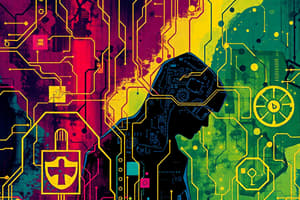Podcast
Questions and Answers
Что подразумевает термин 'фишинг'?
Что подразумевает термин 'фишинг'?
- Кража личной информации путем маскировки легитимных источников (correct)
- Зашифровывание данных для получения выкупа
- Использование вредоносного кода для несанкционированного доступа
- Блокирование файлов до выплаты выкупа
Что представляет собой 'рансомваре'?
Что представляет собой 'рансомваре'?
- Зашифровывание данных для получения выкупа
- Кража личной информации путем маскировки легитимных источников
- Блокирование файлов до выплаты выкупа (correct)
- Использование вредоносного кода для несанкционированного доступа
Что может произойти в результате 'кражи личной информации'?
Что может произойти в результате 'кражи личной информации'?
- Блокирование финансовых средств до уплаты штрафа
- Шифрование данных до выплаты выкупа
- Материальные убытки, юридические проблемы и ущерб в репутации (correct)
- Использование вирусов для повреждения устройства
Что представляет собой 'вредоносное ПО'?
Что представляет собой 'вредоносное ПО'?
Что включает в себя 'техника социальной инженерии'?
Что включает в себя 'техника социальной инженерии'?
Что такое социальная инженерия в контексте кибербезопасности?
Что такое социальная инженерия в контексте кибербезопасности?
Какие тактики часто используются в социальной инженерии?
Какие тактики часто используются в социальной инженерии?
Какие последствия может иметь киберпреступность помимо финансовых потерь?
Какие последствия может иметь киберпреступность помимо финансовых потерь?
Какие стратегии применяются для борьбы с киберпреступностью?
Какие стратегии применяются для борьбы с киберпреступностью?
Что требует динамичный характер киберпреступности по мнению автора текста?
Что требует динамичный характер киберпреступности по мнению автора текста?
Study Notes
Understanding Cyber Threats: Exploring Key Concepts
Cybercrime refers to criminal activities carried out via computer networks and electronic devices. As society increasingly relies on digital technologies, the risks associated with cybercrime have grown exponentially. Some of the primary forms of cybercrime include phishing, ransomware, identity theft, malware attacks, and social engineering techniques.
Phishing
Phishing involves tricking individuals into revealing confidential information, often through deceptive emails or websites that mimic legitimate ones. These messages may appear to come from trusted entities, asking for login credentials, financial details, or other sensitive data.
Ransomware
Ransomware is a type of malicious software that enters a computing system and locks files until a ransom is paid. Once activated, it encrypts data and demands payment for decryption keys.
Identity Theft
Identity theft occurs when someone steals another person's identifying information—such as name, address, or Social Security Number—and uses it for illicit purposes. This can lead to financial losses, legal problems, and reputational damage.
Malware
Malware, short for malicious software, includes various types of malicious code intended to disrupt, damage, or gain unauthorized access to a device. Examples range from viruses to worms, Trojan horses, spyware, and rootkits.
Social Engineering
Social engineering is the act of manipulating people into performing actions or divulging confidential information. It exploits human psychology rather than technical vulnerabilities. Common tactics include impersonating authority figures, creating urgency, or preying upon trust.
The cost of cybercrime is substantial. Estimates put the global loss from cybercrime at over $6 trillion in 2021, with projections suggesting it could exceed $10.5 trillion by 2025. The impacts extend beyond monetary losses, including threats to national security, harm to democratic processes, and significant emotional distress for victims.
To combat cybercrime, various strategies are employed, including education campaigns to raise public awareness, regulatory frameworks to hold businesses accountable for their cybersecurity posture, and advancements in detection and mitigation technologies. Despite progress, however, the landscape remains dynamic, necessitating continuous innovation and adaptation in defense mechanisms.
Studying That Suits You
Use AI to generate personalized quizzes and flashcards to suit your learning preferences.
Description
Test your knowledge on cyber threats and cybercrime concepts such as phishing, ransomware, identity theft, malware, and social engineering. Explore the different forms of cybercrime, their impacts, and strategies to combat them.




